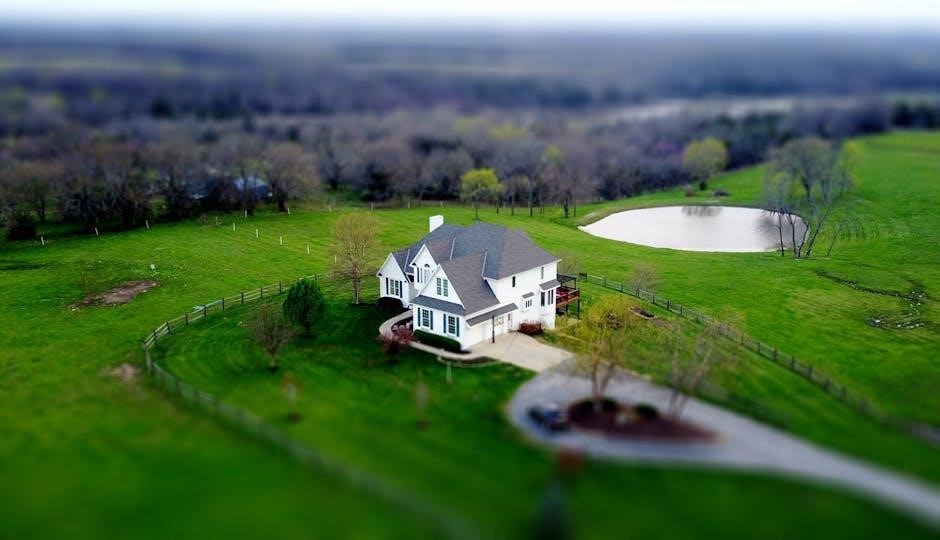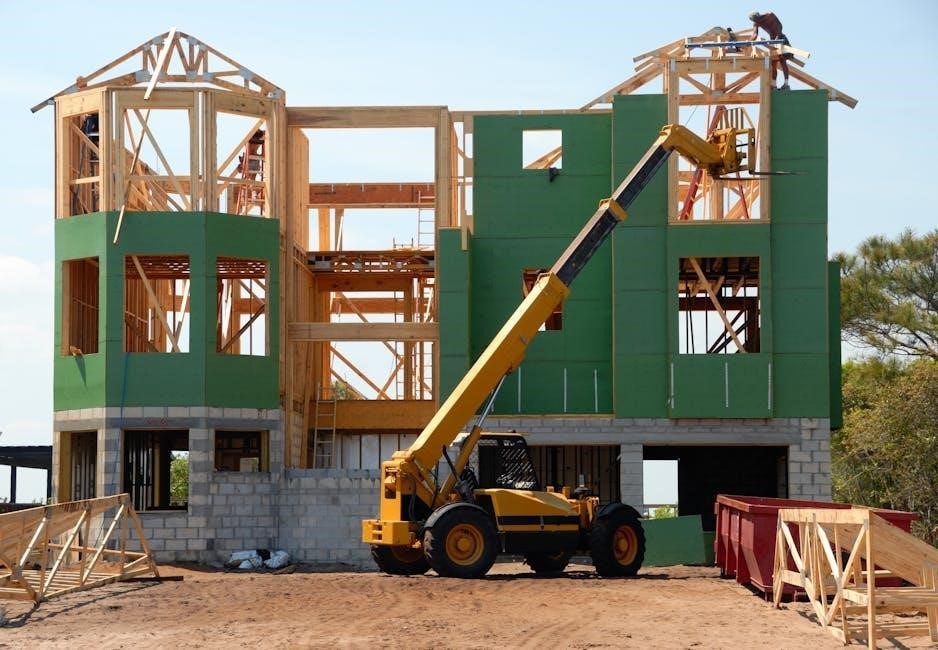The Property Disclosure Statement in British Columbia is a legal document required for residential property sales, ensuring transparency by disclosing known defects and property conditions to buyers.
1.1 Purpose of the Property Disclosure Statement
The purpose of the Property Disclosure Statement is to provide buyers with accurate information about the property’s condition, ensuring transparency in real estate transactions. It requires sellers to disclose known defects, issues, or concerns, such as structural problems, water damage, or environmental hazards. This document aims to protect both parties by reducing potential disputes and ensuring that buyers are fully informed before finalizing a purchase. It is a legal requirement in British Columbia, promoting fairness and accountability in the residential real estate market.
1.2 Legal Requirements for Sellers in BC
In British Columbia, sellers of residential properties are legally required to complete a Property Disclosure Statement. This mandate ensures sellers provide factual information about the property’s condition, including known defects and issues. Sellers must disclose details about structural integrity, water and sewer systems, environmental concerns, and any other material facts. The statement must be completed honestly and accurately, as misrepresentation can lead to legal consequences. Compliance with this requirement is essential to protect both sellers and buyers, ensuring transparency and fairness in real estate transactions across the province.

Key Components of the Property Disclosure Statement
The statement includes disclosures on known defects, structural integrity, water and sewer systems, and environmental concerns, ensuring comprehensive transparency for buyers.
2.1 Known Defects and Repairs
The Property Disclosure Statement requires sellers to disclose known defects and repairs, ensuring transparency about the property’s condition. This includes structural issues, water damage, or needed repairs, providing buyers with crucial information to make informed decisions. Sellers must truthfully report any known problems to avoid legal disputes. This section ensures clarity and accountability, protecting both parties by outlining the property’s current state and any required maintenance or fixes.
2.2 Structural Integrity and Systems
The Property Disclosure Statement requires sellers to detail the structural integrity and condition of major systems in the property. This includes foundations, roofs, walls, and key systems like electrical, plumbing, and HVAC. Sellers must disclose any known issues or needed repairs, ensuring buyers are aware of the property’s overall stability and functionality. This section helps buyers assess potential costs and safety concerns, promoting transparency and informed decision-making in the purchase process.
2.3 Water and Sewer Systems
The Property Disclosure Statement requires sellers to disclose the condition and functionality of water and sewer systems. This includes details about the water supply source, treatment systems, and any known issues with pipes or connections. Sellers must also report on septic systems, including their age, condition, and last inspection date. This ensures buyers are informed about potential costs or maintenance needs, promoting transparency and helping them make informed decisions regarding the property’s water and waste management infrastructure.
2.4 Environmental Concerns
The Property Disclosure Statement requires sellers to disclose environmental concerns affecting the property. This includes information about soil contamination, asbestos, lead paint, or nearby industrial activities. Sellers must also report if the property is in a flood zone or has a history of environmental hazards. Additionally, any known issues with mold, radon, or other hazardous substances must be revealed. This ensures buyers are aware of potential environmental risks and associated costs, promoting transparency and aiding in making informed purchase decisions.

The Role of the British Columbia Real Estate Association (BCREA)
The British Columbia Real Estate Association (BCREA) develops and maintains the Property Disclosure Statement form, ensuring it meets legal standards and provides clear guidelines for sellers.
3.1 Development of the Disclosure Form
The British Columbia Real Estate Association (BCREA) developed the Property Disclosure Statement to standardize the process of revealing property conditions. It ensures sellers provide accurate and comprehensive information to buyers. The form covers key areas such as known defects, structural integrity, water systems, and environmental concerns. By creating a uniform document, BCREA helps sellers comply with legal obligations and reduces potential disputes. The form is regularly updated to reflect changing regulations and industry standards, ensuring it remains relevant and effective in protecting both parties involved in real estate transactions.
3.2 Guidelines for Completing the Statement
To ensure accuracy, sellers must complete the Property Disclosure Statement honestly and thoroughly. Each question should be answered based on the seller’s knowledge and any available documentation. Sellers are responsible for disclosing known defects and material facts about the property. If unsure about a specific issue, consulting professionals, such as inspectors or lawyers, is recommended. The form must be signed and dated by the seller, and a copy provided to the buyer. Proper completion helps avoid legal disputes and ensures compliance with British Columbia’s real estate regulations.

Legal Implications of the Disclosure Statement
Failure to disclose known property issues can result in legal consequences, including lawsuits and financial penalties for non-compliance with British Columbia’s real estate regulations.
4.1 Consequences of Non-Disclosure
Failure to disclose known property defects or issues can lead to legal action, including lawsuits and financial penalties. Sellers may face claims for misrepresentation or negligence, resulting in potential damages. Non-disclosure can also void sales agreements or delay transactions. The onus is on sellers to provide accurate information, as omission of material facts can lead to legal repercussions. This underscores the importance of completing the Property Disclosure Statement truthfully and thoroughly to avoid future disputes.
4.2 Buyer’s Rights and Recourse
Buyers in British Columbia have legal rights to accurate and complete disclosure of a property’s condition. If a seller fails to disclose known defects or provides misleading information, buyers may seek legal recourse. This includes the right to sue for damages or request the rescission of the sale. Buyers can also pursue compensation for repairs or reductions in the purchase price. The Property Disclosure Statement serves as a critical document in protecting buyers’ interests and ensuring transparency in real estate transactions.

Instructions for Completing the Disclosure Form
Sellers must answer all questions honestly and accurately, providing detailed information about the property’s condition, including known defects and necessary repairs or upgrades.
5.1 Understanding the Questions
The Property Disclosure Statement includes specific questions about the property’s condition, such as structural integrity, water systems, and environmental concerns. Sellers must carefully read and understand each question to provide accurate responses. Questions are designed to uncover known defects, necessary repairs, and potential risks. It’s important to seek clarification if any questions are unclear. Understanding the questions ensures compliance with legal requirements and helps sellers avoid unintentional misrepresentation. Professional advice may be needed for complex issues to ensure responses are truthful and complete.
5.2 Importance of Accurate Responses
Accurate responses in the Property Disclosure Statement are crucial for ensuring transparency and fairness in real estate transactions. They protect sellers from potential legal disputes by providing truthful information about the property’s condition. Inaccurate or incomplete answers can lead to costly lawsuits and damage to the seller’s reputation. Buyers rely on this document to make informed decisions, so truthful disclosure fosters trust and smooth transactions. Ensuring accuracy also helps prevent future disputes, benefiting both parties involved in the process and ensuring compliance with legal requirements.

Common Mistakes to Avoid
Overlooking known defects and misrepresenting property condition are common mistakes that can lead to legal disputes and financial losses for sellers in British Columbia.
6.1 Overlooking Known Issues
One of the most common mistakes sellers make is failing to disclose known issues with the property. This includes structural damage, water leaks, or needed repairs. Overlooking these problems can lead to legal disputes and financial losses. Sellers must ensure they accurately report all known defects to avoid misrepresentation claims. Neglecting to address these issues can result in lawsuits, costly repairs, or even the reversal of the sale. Honest and thorough disclosure is essential to protect both parties and ensure a smooth transaction.
6.2 Misrepresentation of Property Condition
Misrepresentation occurs when sellers intentionally or unintentionally provide false or misleading information about the property’s condition. This can include downplaying known defects or omitting critical details. Such actions can lead to legal consequences, as buyers may seek remedies for fraud or breach of contract. Sellers must ensure all disclosures are truthful and accurate to avoid potential lawsuits and financial repercussions. Misrepresentation undermines trust and can result in significant legal and financial fallout for sellers. Honesty is paramount to maintain integrity in real estate transactions.

The Role of the Real Estate Council of British Columbia (RECBC)
RECBC oversees the real estate industry in BC, ensuring compliance with regulations and ethical standards. It licenses professionals, enforces disclosure requirements, and protects consumer interests through regulatory actions.
7.1 Oversight and Enforcement
The Real Estate Council of British Columbia (RECBC) ensures compliance with real estate regulations, including property disclosure requirements. It licenses professionals, investigates complaints, and enforces standards to protect consumers. RECBC conducts audits and reviews to verify adherence to disclosure rules, addressing violations through penalties or corrective actions. This oversight guarantees that sellers and agents provide accurate information, maintaining transparency and fairness in real estate transactions. RECBC’s enforcement mechanisms are crucial for upholding ethical practices and safeguarding buyer interests in BC’s residential market.
7.2 Consumer Protection Measures
The Real Estate Council of British Columbia (RECBC) implements measures to protect consumers by ensuring accurate and timely disclosure of property information. Mandatory disclosure requirements help buyers make informed decisions, reducing potential disputes. RECBC also provides educational resources for buyers and sellers, promoting awareness of their rights and responsibilities. Additionally, the council offers a complaint resolution process for buyers who feel misled, ensuring accountability and fairness in residential real estate transactions across BC.

Electronic Signatures and Digital Formats
In British Columbia, electronic signatures are legally recognized for property disclosure statements, streamlining the process. Sellers can sign and submit the form digitally, enhancing efficiency and convenience.
8.1 Validity of Electronic Signatures in BC
In British Columbia, electronic signatures are legally valid for property disclosure statements under the Electronic Transactions Act. This legislation ensures digital signatures carry the same legal weight as handwritten ones, streamlining real estate transactions. Sellers and buyers can confidently use electronic platforms to sign and submit disclosure forms, knowing the process is secure and legally binding. This modern approach enhances efficiency while maintaining the integrity of the disclosure process.
8.2 Accessing the PDF Form Online
The Property Disclosure Statement for residential properties in BC is readily available online as a downloadable PDF. The British Columbia Real Estate Association (BCREA) provides this form on their official website. Sellers can access it by visiting the BCREA site, navigating to the resources or forms section, and downloading the PDF. The form includes sections for detailing property conditions, water systems, and structural issues. Online access ensures convenience and efficiency for sellers preparing their disclosure statements.

Regional Variations in Disclosure Requirements
British Columbia municipalities may have varying disclosure requirements, with rural properties often needing additional considerations due to unique local regulations and environmental factors.
9.1 Differences Across BC Municipalities
Disclosure requirements in British Columbia vary across municipalities, as local bylaws and regulations may differ. Urban areas like Vancouver and Victoria often have specific rules, while rural municipalities may require additional disclosures related to land use, zoning, or environmental factors. Sellers must comply with local regulations, which may include unique forms or supplementary information. It is essential to consult local authorities to ensure all requirements are met, as failure to comply could lead to legal consequences. Understanding these variations is crucial for a smooth transaction process.
9.2 Special Considerations for Rural Properties
Rural properties in British Columbia often require additional disclosures due to unique characteristics such as wells, septic systems, and agricultural zoning. Sellers must disclose known issues related to water quality, soil conditions, or environmental concerns. Rural properties may also involve specific regulations regarding land use or easements. Disclosures should include details about outbuildings, rights-of-way, or nearby industrial activities that could impact the property. These considerations ensure buyers are fully informed about potential challenges or limitations specific to rural land ownership.

Benefits for Sellers and Buyers
The Property Disclosure Statement in British Columbia offers legal protection for sellers and transparency for buyers, ensuring clear communication about property conditions and potential issues.
10.1Seller’s Legal Protection
The Property Disclosure Statement provides sellers with legal protection by ensuring they disclose known defects and property conditions. This transparency reduces the risk of future disputes or lawsuits from buyers. By completing the form honestly, sellers demonstrate compliance with legal requirements, potentially avoiding claims of misrepresentation. The document acts as a safeguard, proving the seller provided accurate information about the property’s condition. This protection is particularly important in British Columbia, where real estate transactions are governed by strict regulations.
10.2 Buyer’s Transparency and Assurance
The Property Disclosure Statement ensures transparency for buyers by providing detailed information about the property’s condition. This document gives buyers assurance by revealing known defects, repairs, and environmental concerns, enabling informed decision-making. It reduces the risk of post-purchase surprises and fosters trust in the transaction. Buyers gain clarity on the property’s state, allowing them to assess its value and negotiate terms confidently. This transparency also protects buyers from potential issues that could arise after ownership transfer, making the disclosure statement a vital tool for fair and informed real estate transactions in British Columbia.